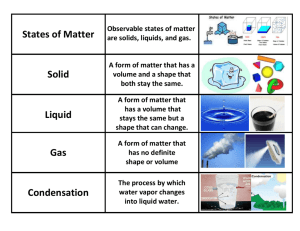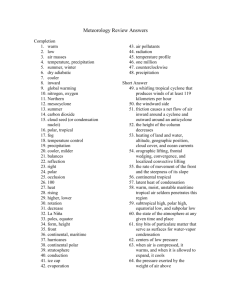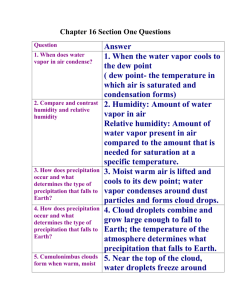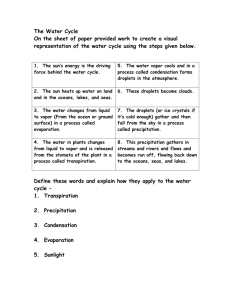Atmospheric Moisture and Precipitation
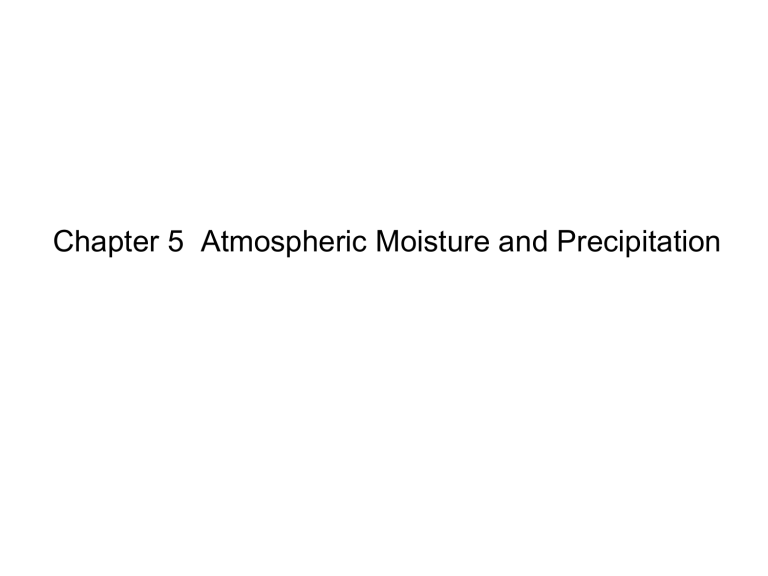
Chapter 5 Atmospheric Moisture and Precipitation
• The hydrologic cycle
Evaporation depends on:
• Temperature
• Wind
• Relative Humidity
Measures of Humidity
Principle: the warmer an air mass, the higher its water vapor capacity
• specific humidity is the mass of water vapor (g) per mass of air (kg)
• dewpoint is the temperature that the air would have to be cooled off to in order to induce condensation.
• vapor pressure: the portion of total air pressure contributed by water vapor molecules, in millibars (mb) or inches of mercury. Higher amounts of humidity mean higher vapor pressure. Higher dwpts: higher vap. press.
• relative humidity
RH% = 100* actual water vapor pressure (determined by dewpt.) saturation vapor pressure (determined by air temp.)
Saturation vapor pressure & temperature
Air Temperature ( °F)
60
70
80
90
20
30
40
50
Saturation Vapor
Pressure (“ Hg)
0.11
0.17
0.25
0.36
0.52
0.74
1.03
1.42
Air Temperature and Saturation
Vapor Pressure
1.5
1
0.5
0
0 50 temperature (degrees F)
100
CONDENSATION
• condensation: when air reaches saturation (~100% relative humidity).
Process: either cool off air to saturate, or add enough water vapor
• condensation nuclei: include salt, dust, smoke, others
• case of dew & frost:
• clouds consist of water droplets and/or ice crystals
Processes of growth of droplets into drops that can fall:
• ice crystal process - ice crystals behave as condensation nuclei: vapor droplets sublimate onto ice crystals
• coalescence process - large droplets fall faster than small droplets and collide/ coalesce with them
Atmospheric Stability & Lapse Rates
• stability condition of the atmosphere when rising air becomes cooler and denser than the surrounding air and is forced to subside.
• instability when rising air becomes warmer and less dense than the surrounding air and continues to rise.
• Environmental Lapse Rate (ELR): observed rate of temperature change in the atm. (average: 0.65 °C/ 100m)
• Dry Adiabatic Rate (DAR): rate at which unsaturated air cools as it is forced upward and expands. (1 °C/ 100m)
• Saturated Adiabatic Rate (SAR): rate at which saturated air cools as it is forced upward and expands. (~0.5 °C/100m)
• Example: chart with average Env. Lapse Rate and unsaturated air parcel.
• Stable conditions do not favor precipitation, unstable conditions do.
Lifting mechanisms & precipitation basic principle: air must be lifted and cooled to the dewpoint in order to induce condensation
1.
orographic precipitation: air forced upslope by winds cools
2.
convectional: surface heating induces air to rise and cool example: thunderstorms, which have 3 stages: developing, mature, dissipating
3. Low pressure systems: mid latitude cyclones, tropical weather systems and Inter Tropical Convergence Zone
4. frontal -front: boundary between air masses of different temperature and humidity, mid latitude cyclone example
Global precipitation map: (see folder)
GLOBAL PRECIPITATION PATTERNS
• view precip. map in folder
• general pattern : high pressure favors aridity (espec. W.
Coasts), low pressure favors precipitation
• Areas of great precipitation
ITCZ (equatorial low) and related Monsoon lands, zone of sub polar lows, the littorals: (trade wind coasts & westerly coasts)
West side of Sub Tropical Highs exception: greater instability and precipitation than E side
Areas of low precipitation
• Stable east side of sub tropical highs (W. Coasts) coastal deserts:
Atacama (SA), Baja Cal., Namibian coast (Africa)
• rain shadow deserts (eg. Mohave and Sonoran)
• Polar deserts: dominated by high pressure and low temps. ensure low moisture content of air and modest annual precip.
Seasonality of precipitation: most regions have their low precipitation season in the low sun season, with the exception of mid-latitude west coasts (such as the west coast of the U.S., W. Australia)
• Advection
• Radiation
• Upslope

